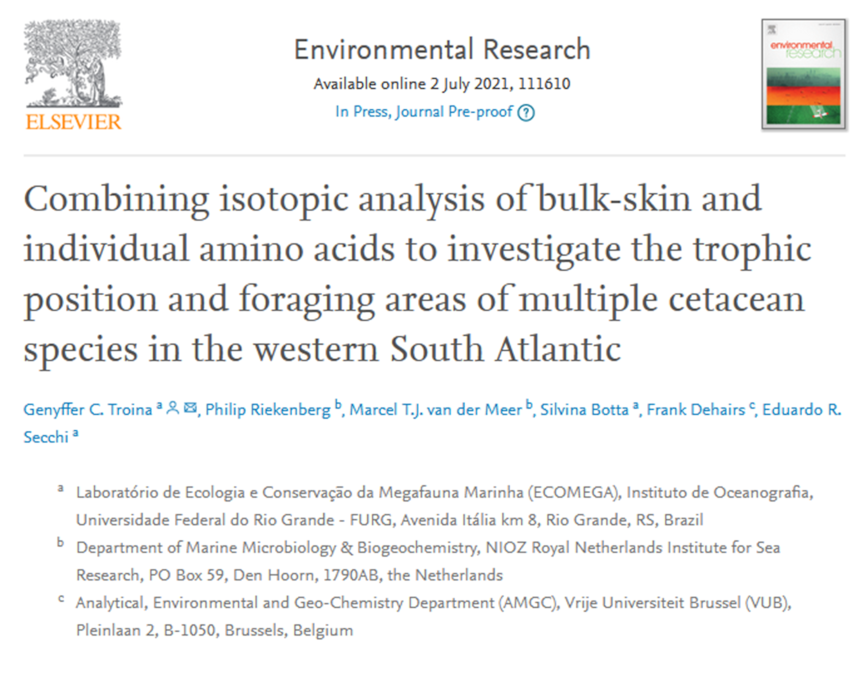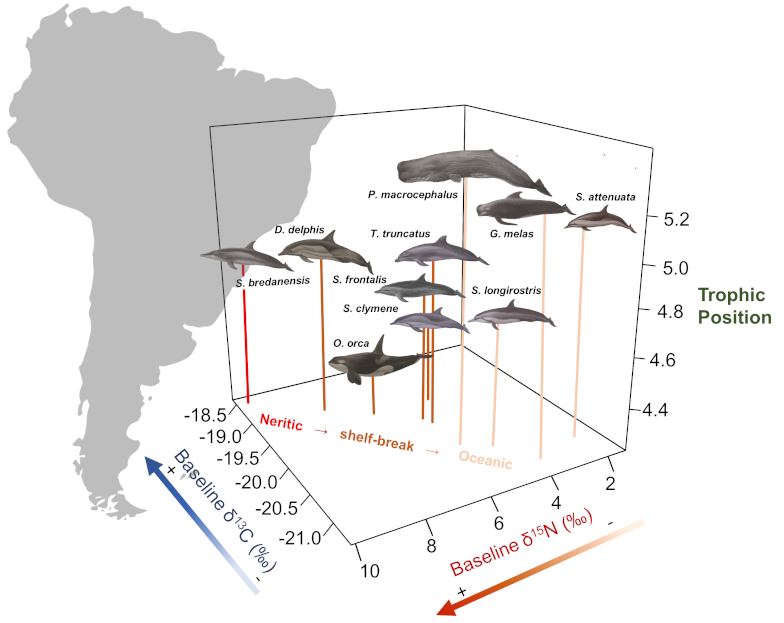A recent study carried out by researchers from the Laboratory of Ecology and Conservation of Marine Megafauna (Laboratório de Ecologia e Conservação da Megafauna Marinha, EcoMega), in collaboration with the Royal Netherlands Institute for Sea Research (NIOZ, Netherlands) and the Vrije Universiteit Brussel (VUB, Belgium) applied a new method to investigate the feeding behavior and habitat use by cetaceans in the oceanic waters of southeast-southern Brazil. The study, led by researcher Genyffer Troina, PhD in Biological Oceanography in the Programa de Pós-Graduação em Oceanografia Biológica at FURG's Institute of Oceanography, was published in the scientific journal Environmental Research. The subject of this research and the international collaboration are within the scope of the Institutional Internationalization Program “Capes-PrInt/FURG”
Little is known about the foraging areas and feeding habits of oceanic cetaceans in the South Atlantic. The little information available about their diet derives mainly from studies analyzing the stomach contents of specimens stranded dead, which depends on these animals reaching the coast after they die. Therefore, it is very difficult to study these animals in their natural environment, and observations of how they hunt are very rare. This makes it difficult to understand how these oceanic cetaceans influence one another in their search for food.
To resolve this, Genyffer analyzed nitrogen stable isotopes in amino acids of skin samples of cetaceans that occur in the southwestern waters off the Atlantic ocean, in Brazil. This new method reveals the differences in the foraging areas and the trophic positions occupied by the different species. For example, data from a previous study led by the same author (https://doi.org/10.1007/s00227-020-03805-8) indicated that the rough-toothed dolphin (Steno bredanensis) could be occupying trophic positions higher than species such as the sperm whale (Physeter macrocephalus) or the killer whale (Orcinus orca), which is unlikely. With the analysis of stable isotopes in amino acids, it was possible to demonstrate that the trophic level of this species is in fact lower than the previous data suggested.
In addition, the method used before indicated great overlap in the use of resources among species. The new analysis show that this overlap is much smaller, as species feed at different depths. For example, the sperm whale forages in the oceanic regions of the continental slope, and occupies the highest trophic position among the cetacean species studied here. The common dolphin (Delphinus delphis) feeds in neritic waters, while the Atlantic spotted dolphin (Stenella frontalis) and the bottlenose dolphin (Tursiops truncatus) search for food along the outer continental shelf. These last two species consume different prey and occupy different trophic positions. This novel study shows that cetacean species from the western South Atlantic have found a way to live together without competing for food.
This work sets an important precedent for studies of marine mammals’ trophic ecology in the South Atlantic and elsewhere.
The complete article is available at: https://doi.org/10.1016/j.envres.2021.111610
Genyffer C. Troina, Philip Riekenberg, Marcel T.J. van der Meer, Silvina Botta, Frank Dehairs, Eduardo R. Secchi. Combining isotopic analysis of bulk-skin and individual amino acids to investigate the trophic position and foraging areas of multiple cetacean species in the western South Atlantic. Environmental Research, available online from July 2, 2021.


Analysis of δ15N in amino acids helped to reveal the trophic structure and habitat use of cetaceans in the oceanic waters of the western South Atlantic. Image: Genyffer C. Troina. Illustration of cetaceans by José Luis Vázquez, adapted from Bastida et al. 2018.





